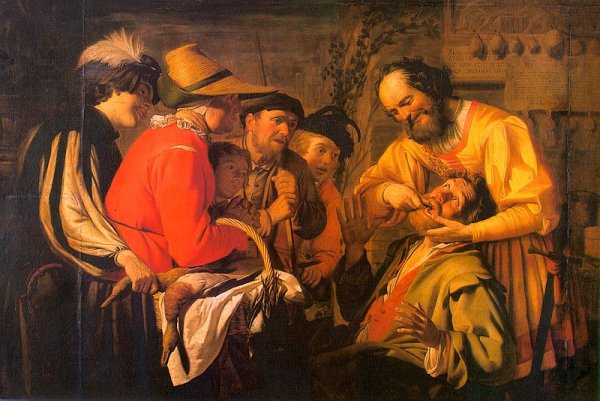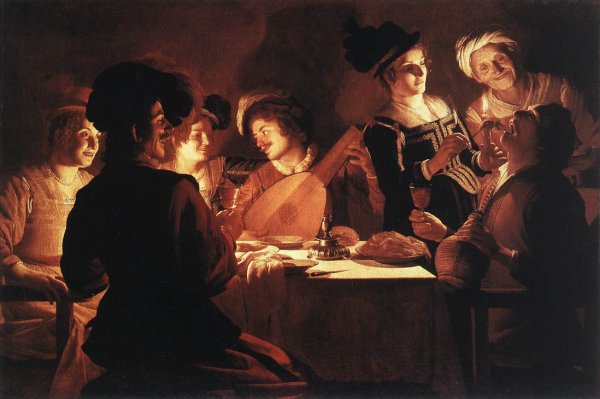Gerrit Van Honthorst Biography In Details
Early years

Gerard van Honthorst (November 4, 1592 - April 27, 1656), also known as Gerrit van Honthorst and Gherardo della Notte, was a Dutch painter of Utrecht. He was brought up at the school of Abraham Bloemaert, who exchanged the style of the Franckens for that of the pseudo-Italians at the beginning of the 16th century.
Infected thus early with a mania which came to be very general in the Netherlands, Honthorst went to Italy in 1616, where he copied the naturalism and eccentricities of Michelangelo da Caravaggio. Home again about 1620, after acquiring a considerable practice in Rome, he set up a school at Utrecht which flourished exceedingly. Together with his colleague Hendrick ter Brugghen, he represented the so-called Dutch Caravaggisti. In 1623 he was president of his gild at Utrecht, where had he married his cousin. He soon became so fashionable that Sir Dudley Carleton, then English envoy at The Hague, recommended his works to the earl of Arundel and Lord Dorchester. In 1626 he received a visit from Rubens, whom he painted as the honest man sought for and found by Diogenes.
The queen of Bohemia, sister of Charles I of England and electress palatine, being in exile in the Netherlands, gave Honthorst her countenance and asked him to teach her children drawing; and Honthorst, thus approved and courted, became known to her brother Charles I, who invited him to England in 1628. There he painted several portraits, and a vast allegory, now at Hampton Court, of Charles and his queen as Diana and Apollo in the clouds receiving the duke of Buckingham as Mercury and guardian of the king of Bohemia's children. Charles I, whose taste was flattered alike by the energy of Rubens and the elegance of Van Dyck, was thus first captivated by the fanciful mediocrity of Honthorst, who though a poor executant had luckily for himself caught, as Lord Arundel said, much of the manner of Caravaggio's colouring, then so much esteemed at Rome.
Court painter

It was Honthorst's habit to transmute every subject into a night scene, from the Nativity, for which there was warrant in the example of Correggio, to the penitence of the Magdalen, for which there was no warrant at all. But unhappily this caprice, though sublime in Allegri and Rembrandt, was but a phantasm in the hands of Honthorst, whose prosaic pencil was not capable of more than vulgar utterances, and art gained little from the repetition of these quaint vagaries. Sandrart gave the measure of Honthorst's popularity at this period when he says that he had as many as twenty apprentices at one time, each of whom paid him a fee of 100 forms a year.
After Honthorst returned from England, he settled anew at Utrecht. His position amongst artists was acknowledged to be important. In his home at Utrecht, Honthorst succeeded in preserving the support of the English monarch, for whom he finished in 1631 a large picture of the king and queen of Bohemia and all their children. For Lord Dorchester about the same period he completed some illustrations of the Odyssey; for the king of Denmark, Christian IV of Denmark, he composed incidents of Danish history, of which one example remains in the gallery of Copenhagen. In the course of a large practice, Honthorst had painted many likenesses of Charles I and his queen, the duke of Buckingham, and the king and queen of Bohemia.
Honthorst now became court painter to the princess of Orange, settled (1637) at The Hague, and painted in succession at the Castle of Ryswick and the House in the Wood. The time not consumed in producing pictures was devoted to portraits.
Honthorst's works are numerous, and amply represented in English and Continental galleries. His most attractive pieces are those in which he cultivates the style of Caravaggio, those, namely, which represent taverns, with players, singers and eaters. He shows great skill in reproducing scenes illuminated by a single candle, amply employing the style of chiaroscuro. But he seems to have studied too much in dark rooms, where the subtleties of flesh colour are lost in the dusky smoothness and uniform redness of tints procurable from farthing dips.
Late years

Of great interest still, though rather sharp in outline and hard in modelling, are Honthorst's portraits of the Duke of Buckingham and Family (Hampton Court), the King and Queen of Bohemia (Hanover and Combe Abbey), Marie de Medici (Amsterdam town-hall), 1628, the Stadtholders and their Wives (Amsterdam and Hague), Charles Louis and Rupert, Charles I's nephews (Louvre, St Petersburg, Combe Abbey and Willin), and Lord Craven, (National Portrait Gallery, London).
Honthorst's early form may be judged by a Lute-player (1614) at the Louvre, the Martyrdom of St John in S. M. della Scala at Rome, or the Liberation of Peter in the Berlin Museum; his latest style is that of the House in the Wood (1648), where he appears to disadvantage by the side of Jordaens and others.
Honthorst was succeeded by his brother William, born at Utrecht in 1604, who died, it is said, in 1666. William lived chiefly in his native place, temporarily at Berlin. But he has left little behind except a portrait at Amsterdam, and likenesses in the Berlin Museum of William and Mary of England. (From Wikipedia)




